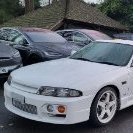R33 Gts-t Anti Roll Bar Link Bracket Snapping, Alternatives?
Announcements
-
Similar Content
-
Latest Posts
-
Well, this, but braided line to the sender that is mounted on the chassis. Oil Pressure doesn't need to be close, while I prefer Oil Temp is in the active oil flow (bro science, not sure how much it matters). That's how I've had mine set up for years and it works OK
-
Welcome back! There is a v series forum, a little quiet at times but every new active member helps
-
But, per MBS206's question, what happens when it doesn't start. When you turn the key to IGN, do the dash lights come on (then go off after a couple of seconds) - likely alarm or other electrical issue When you turn the key to STRT do you head a clear click (the starter solenoid trying) without the engine turning (likely starter motor)
-
I had 3 counts over the last couple of weeks once where i got stranded at a jdm paint yard booking in some work. 2nd time was moving the car into the drive way for the inspection and the 3rd was during the inspection for the co2 leak test. Fix: 1st, car off for a hour and half disconnected battery 10mins 4th try car started 2nd, 5th try started 3rd, countless time starting disconnected battery dude was under the hood listening to the starting sequence fuel pump ect.
-
This. As for your options - I suggest remote mounting the Nissan sensor further away on a length of steel tube. That tube to have a loop in it to handle vibration, etc etc. You will need to either put a tee and a bleed fitting near the sensor, or crack the fitting at the sensor to bleed it full of oil when you first set it up, otherwise you won't get the line filled. But this is a small problem. Just needs enough access to get it done.
-





Recommended Posts
Create an account or sign in to comment
You need to be a member in order to leave a comment
Create an account
Sign up for a new account in our community. It's easy!
Register a new accountSign in
Already have an account? Sign in here.
Sign In Now